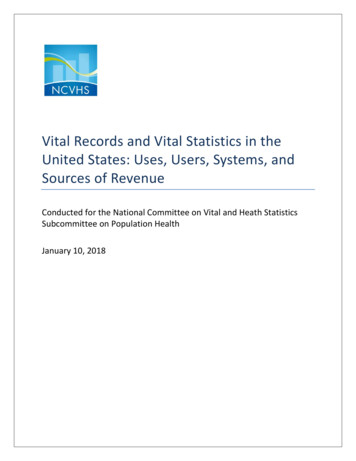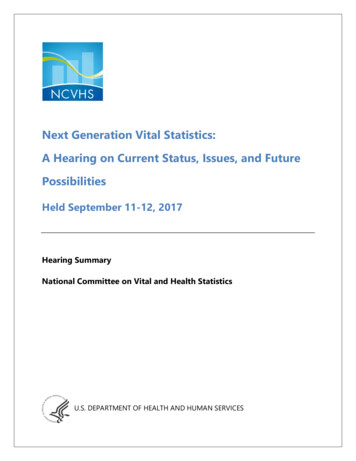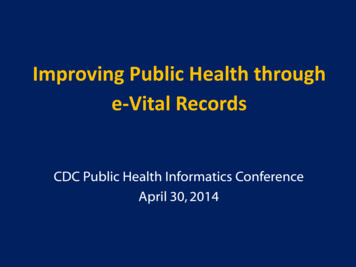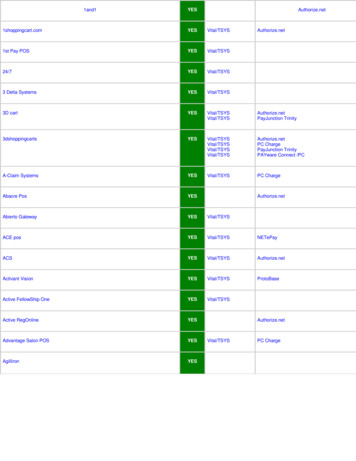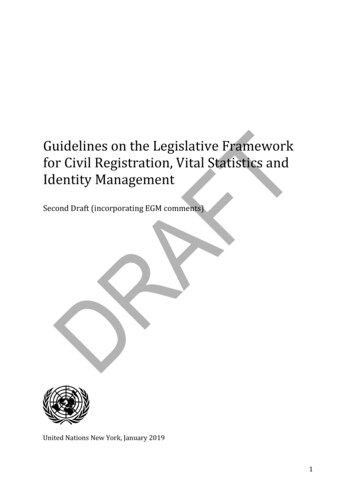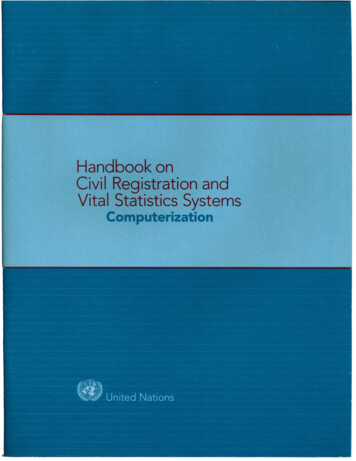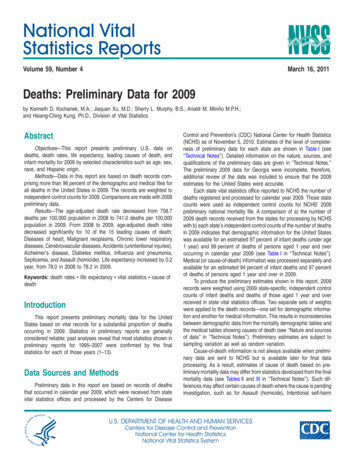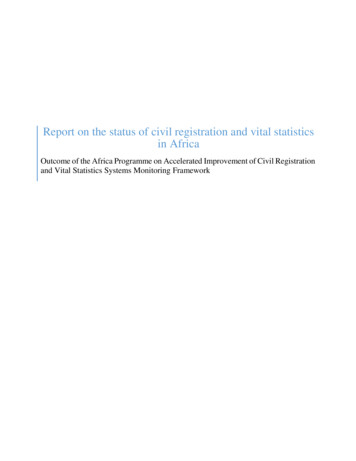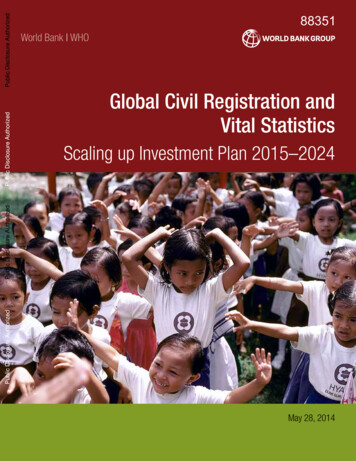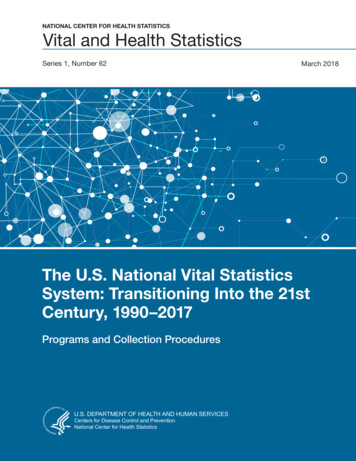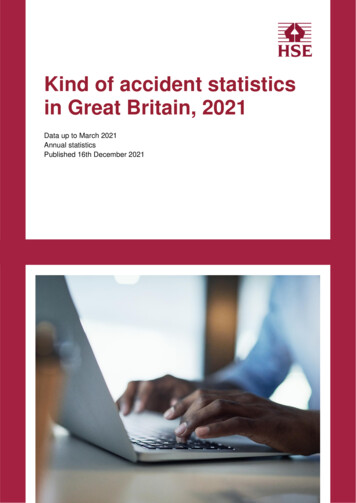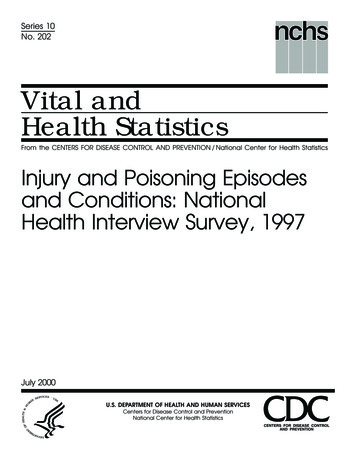
Transcription
Series 10No. 202Press for ErrataVital andHealth StatisticsFrom the CENTERS FOR DISEASE CONTROL AND PREVENTION / National Center for Health StatisticsInjury and Poisoning Episodesand Conditions: NationalHealth Interview Survey, 1997July 2000U.S. DEPARTMENT OF HEALTH AND HUMAN SERVICESCenters for Disease Control and PreventionNational Center for Health Statistics
Copyright InformationAll material appearing in this report is in the public domain and may bereproduced or copied without permission; citation as to source, however, isappreciated.Suggested CitationWarner M, Barnes PM, and Fingerhut LA. Injury and poisoning episodes andconditions; National Health Interview Survey, 1997. Vital Health Stat 10(202).2000.Library of Congress-in-Publication DataInjury and poisoning episodes and conditions: National Health Interview Survey,1997.p.; cm.—(Vital and health statistics. Series 10, Data from the NationalHealth Survey ; no. 202) (DHHS publication ; no. (PHS) 2000-1530)‘‘June 2000.’’Includes bibliographical references.ISBN 0-8406-0563-31. Wounds and injuries—United States—Statistics. 2. Poisoning—United States—Statistics. 3. United States—Statistics, Medical. I. NationalCenter for Health Statistics (U.S.) II. Series. III. Series: DHHS publication ; no.(PHS) 2000-1530.[DNLM: 1. National Health Interview Survey (U.S.) 2. Wounds andInjuries—United States—Statistics. 3. Health Surveys—United States.4. Poisoning—United States—Statistics. W2 A N148VJ no, 202 2000]RA407.3.A346 no. 202[RA645.T73]362.1’0973’021 s—dc21[617.1’00973021]00-041852For sale by the U.S. Government Printing OfficeSuperintendent of DocumentsMail Stop: SSOPWashington, DC 20402-9328Printed on acid-free paper.
Vital andHealth StatisticsInjury and Poisoning Episodesand Conditions: NationalHealth Interview Survey, 1997Series 10:Data From the National HealthInterview SurveyNo. 202U.S. DEPARTMENT OF HEALTH AND HUMAN SERVICESCenters for Disease Control and PreventionNational Center for Health StatisticsHyattsville, MarylandJuly 2000DHHS Publication No. (PHS) 2000-1530
National Center for Health StatisticsEdward J. Sondik, Ph.D., DirectorJack R. Anderson, Deputy DirectorJack R. Anderson, Acting Associate Director forInternational StatisticsJennifer H. Madans, Ph.D., Associate Director for ScienceLester R. Curtin, Ph.D., Acting Associate Director forResearch and MethodologyJennifer H. Madans, Ph.D., Acting Associate Director forAnalysis, Epidemiology, and Health PromotionP. Douglas Williams, Acting Associate Director for DataStandards, Program Development, and Extramural ProgramsEdward L. Hunter, Associate Director for Planning, Budget,and LegislationJennifer H. Madans, Ph.D., Acting Associate Director forVital and Health Statistics SystemsDouglas L. Zinn, Acting Associate Director forManagementCharles J. Rothwell, Associate Director for DataProcessing and ServicesOffice of Analysis, Epidemiology, and Health PromotionJennifer H. Madans, Ph.D., Acting Associate Director forAnalysis, Epidemiology, and Health PromotionLois A. Fingerhut, M.A., Special Assistant for InjuryEpidemiologyDivision of Health Interview StatisticsJane F. Gentleman, Ph.D., DirectorSusan S. Jack, M.S., Acting Chief, Illness and DisabilityStatistics BranchCooperation of the U.S. Bureau of the CensusUnder the legislation establishing the National Health Survey, the Public HealthService is authorized to use, insofar as possible, the services or facilities of otherFederal, State, or private agencies.In accordance with specifications established by the National Center for HealthStatistics, the U.S. Bureau of the Census, under a contractual arrangement, participatedin planning the survey and collecting the data.
ContentsAbstract . . . . . . . . . . . . . . . . . . . . . . . . . . . . . . . . . . . . . . . . . . . . . . . . . . . . . . . . . . . . . . . . . . . . . . . . . . . . . . . . . . . . . . . . . . . . . . . . .1Highlights. . . . . . . . . . . . . . . . . . . . . . . . . . . . . . . . . . . . . . . . . . . . . . . . . . . . . . . . . . . . . . . . . . . . . . . . . . . . . . . . . . . . . . . . . . . . . . . .1Introduction . . . . . . . . . . . . . . . . . . . . . . . . . . . . . . . . . . . . . . . . . . . . . . . . . . . . . . . . . . . . . . . . . . . . . . . . . . . . . . . . . . . . . . . . . . . . .2Methods . . . . . . . . . . . . . . . . . . . . . . . . . . . . . . . . . . . . . . . . . . . . . . . . . . . . . . . . . . . . . . . . . . . . . . . . . . . . . . . . . . . . . . . . . . . . . . . .Source of Data . . . . . . . . . . . . . . . . . . . . . . . . . . . . . . . . . . . . . . . . . . . . . . . . . . . . . . . . . . . . . . . . . . . . . . . . . . . . . . . . . . . . . . .Capturing Episodes of Injury and Poisoning . . . . . . . . . . . . . . . . . . . . . . . . . . . . . . . . . . . . . . . . . . . . . . . . . . . . . . . . . . . . . . .Analysis Fields . . . . . . . . . . . . . . . . . . . . . . . . . . . . . . . . . . . . . . . . . . . . . . . . . . . . . . . . . . . . . . . . . . . . . . . . . . . . . . . . . . . . . . .Sample Size and Response Rates . . . . . . . . . . . . . . . . . . . . . . . . . . . . . . . . . . . . . . . . . . . . . . . . . . . . . . . . . . . . . . . . . . . . . . . .Data Files . . . . . . . . . . . . . . . . . . . . . . . . . . . . . . . . . . . . . . . . . . . . . . . . . . . . . . . . . . . . . . . . . . . . . . . . . . . . . . . . . . . . . . . . . . .Units of Analysis, Annual Estimates, and Rates . . . . . . . . . . . . . . . . . . . . . . . . . . . . . . . . . . . . . . . . . . . . . . . . . . . . . . . . . . . . .Variance Estimation and Significance Testing . . . . . . . . . . . . . . . . . . . . . . . . . . . . . . . . . . . . . . . . . . . . . . . . . . . . . . . . . . . . . .Age-adjusted Rates . . . . . . . . . . . . . . . . . . . . . . . . . . . . . . . . . . . . . . . . . . . . . . . . . . . . . . . . . . . . . . . . . . . . . . . . . . . . . . . . . . . .222444455Results . . . . . . . . . . . . . . . . . . . . . . . . . . . . . . . . . . . . . . . . . . . . . . . . . . . . . . . . . . . . . . . . . . . . . . . . . . . . . . . . . . . . . . . . . . . . . . . . .Age, Sex, and Race/Ethnicity . . . . . . . . . . . . . . . . . . . . . . . . . . . . . . . . . . . . . . . . . . . . . . . . . . . . . . . . . . . . . . . . . . . . . . . . . . .Leading External Causes of Injury . . . . . . . . . . . . . . . . . . . . . . . . . . . . . . . . . . . . . . . . . . . . . . . . . . . . . . . . . . . . . . . . . . . . . . .Injury Conditions . . . . . . . . . . . . . . . . . . . . . . . . . . . . . . . . . . . . . . . . . . . . . . . . . . . . . . . . . . . . . . . . . . . . . . . . . . . . . . . . . . . . .Place of Injury . . . . . . . . . . . . . . . . . . . . . . . . . . . . . . . . . . . . . . . . . . . . . . . . . . . . . . . . . . . . . . . . . . . . . . . . . . . . . . . . . . . . . . .Activity at Time of Injury . . . . . . . . . . . . . . . . . . . . . . . . . . . . . . . . . . . . . . . . . . . . . . . . . . . . . . . . . . . . . . . . . . . . . . . . . . . . . .Hospitalization . . . . . . . . . . . . . . . . . . . . . . . . . . . . . . . . . . . . . . . . . . . . . . . . . . . . . . . . . . . . . . . . . . . . . . . . . . . . . . . . . . . . . . .School- and Work-loss Days . . . . . . . . . . . . . . . . . . . . . . . . . . . . . . . . . . . . . . . . . . . . . . . . . . . . . . . . . . . . . . . . . . . . . . . . . . . .Limitations After Injury . . . . . . . . . . . . . . . . . . . . . . . . . . . . . . . . . . . . . . . . . . . . . . . . . . . . . . . . . . . . . . . . . . . . . . . . . . . . . . . .6668899910Discussion . . . . . . . . . . . . . . . . . . . . . . . . . . . . . . . . . . . . . . . . . . . . . . . . . . . . . . . . . . . . . . . . . . . . . . . . . . . . . . . . . . . . . . . . . . . . . . .Strengths of the Redesign . . . . . . . . . . . . . . . . . . . . . . . . . . . . . . . . . . . . . . . . . . . . . . . . . . . . . . . . . . . . . . . . . . . . . . . . . . . . . .Limitations and Lessons Learned . . . . . . . . . . . . . . . . . . . . . . . . . . . . . . . . . . . . . . . . . . . . . . . . . . . . . . . . . . . . . . . . . . . . . . . .Comparability with Prior Years . . . . . . . . . . . . . . . . . . . . . . . . . . . . . . . . . . . . . . . . . . . . . . . . . . . . . . . . . . . . . . . . . . . . . . . . . .Conclusion . . . . . . . . . . . . . . . . . . . . . . . . . . . . . . . . . . . . . . . . . . . . . . . . . . . . . . . . . . . . . . . . . . . . . . . . . . . . . . . . . . . . . . . . . . .1010111213References . . . . . . . . . . . . . . . . . . . . . . . . . . . . . . . . . . . . . . . . . . . . . . . . . . . . . . . . . . . . . . . . . . . . . . . . . . . . . . . . . . . . . . . . . . . . . . .13AppendixesI.NHIS Questionnaire, Family Core: Section II—Injuries . . . . . . . . . . . . . . . . . . . . . . . . . . . . . . . . . . . . . . . . . . . . . . . . . . . .26II.Matrix for External Cause of Injury Mortality and Morbidity Data . . . . . . . . . . . . . . . . . . . . . . . . . . . . . . . . . . . . . . . . . . .33III.Injury Morbidity Matrix . . . . . . . . . . . . . . . . . . . . . . . . . . . . . . . . . . . . . . . . . . . . . . . . . . . . . . . . . . . . . . . . . . . . . . . . . . . . . 34Codes for Body Region of Injury . . . . . . . . . . . . . . . . . . . . . . . . . . . . . . . . . . . . . . . . . . . . . . . . . . . . . . . . . . . . . . . . . . . 34Codes for Nature of Injury . . . . . . . . . . . . . . . . . . . . . . . . . . . . . . . . . . . . . . . . . . . . . . . . . . . . . . . . . . . . . . . . . . . . . . . . 37IV.Technical Notes . . . . . . . . . . . . . . . . . . . . . . . . . . . . . . . . . . . . . . . . . . . . . . . . . . . . . . . . . . . . . . . . . . . . . . . . . . . . . . . . . . . .38Detailed Tables1.Number, percent distribution, standard error, and annual rate of injury and poisoning episodes by selected demographiccharacteristics: United States, 1997 . . . . . . . . . . . . . . . . . . . . . . . . . . . . . . . . . . . . . . . . . . . . . . . . . . . . . . . . . . . . . . . . . . . . 16iii
2.3.4.5.6.7.8.9.10.11.Annual rate and standard error of leading external causes of injury and poisoning episodes by sex and age:United States, 1997. . . . . . . . . . . . . . . . . . . . . . . . . . . . . . . . . . . . . . . . . . . . . . . . . . . . . . . . . . . . . . . . . . . . . . . . . . . . . . . . . .Number, percent, and standard error of fall-related episodes and percent by type of fall and sex: United States, 1997 . .Number, percent, and standard error of transportation-related episodes by selected characteristics and sex:United States, 1997 . . . . . . . . . . . . . . . . . . . . . . . . . . . . . . . . . . . . . . . . . . . . . . . . . . . . . . . . . . . . . . . . . . . . . . . . . . . . . . . . .Number of poisoning episodes, number and percent of poisoning episodes involving a call to a poison control center,and standard error by sex and age: United States, 1997 . . . . . . . . . . . . . . . . . . . . . . . . . . . . . . . . . . . . . . . . . . . . . . . . . . . .Annual rate and standard error of conditions by the nature of the injury and sex and age: United States,1997. . . . . . . . . . . . . . . . . . . . . . . . . . . . . . . . . . . . . . . . . . . . . . . . . . . . . . . . . . . . . . . . . . . . . . . . . . . . . . . . . . . . . . . . . . . . . .Annual rate and standard error of injury conditions by body region injured and sex and age: United States, 1997 . . . .Number, percent, and standard error of injury episodes by place of occurrence, activity engaged in, and sex:United States, 1997 . . . . . . . . . . . . . . . . . . . . . . . . . . . . . . . . . . . . . . . . . . . . . . . . . . . . . . . . . . . . . . . . . . . . . . . . . . . . . . . . .Number, percent, and standard error of injury and poisoning episodes involving hospitalization by sex and age:United States, 1997 . . . . . . . . . . . . . . . . . . . . . . . . . . . . . . . . . . . . . . . . . . . . . . . . . . . . . . . . . . . . . . . . . . . . . . . . . . . . . . . . .Number, annual rates, and standard error of injury episodes resulting in time lost from work or school:United States, 1997. . . . . . . . . . . . . . . . . . . . . . . . . . . . . . . . . . . . . . . . . . . . . . . . . . . . . . . . . . . . . . . . . . . . . . . . . . . . . . . . . .Number, percent, and standard error of injury episodes by whether persons required help with daily routine activitiesor personal care and age and sex: United States, 1997 . . . . . . . . . . . . . . . . . . . . . . . . . . . . . . . . . . . . . . . . . . . . . . . . . . . . .18191920212223242425List of 8.19.20.ivInjury and poisoning episode rates by age: United States, 1997 . . . . . . . . . . . . . . . . . . . . . . . . . . . . . . . . . . . . . . . . . . . . .Injury and poisoning episode rates by age and sex: United States, 1997 . . . . . . . . . . . . . . . . . . . . . . . . . . . . . . . . . . . . . .Injury and poisoning episode rates by age, race, and ethnicity: United States, 1997 . . . . . . . . . . . . . . . . . . . . . . . . . . . . . .Age-adjusted external cause of injury and poisoning episode rates by mechanism of injury and sex: United States,1997 . . . . . . . . . . . . . . . . . . . . . . . . . . . . . . . . . . . . . . . . . . . . . . . . . . . . . . . . . . . . . . . . . . . . . . . . . . . . . . . . . . . . . . . . . . . . .Injury episode rates for falls by age and sex: United States, 1997 . . . . . . . . . . . . . . . . . . . . . . . . . . . . . . . . . . . . . . . . . . .Injury episode rates for being struck by or against an object or person by age and sex: United States, 1997 . . . . . . . . .Injury episode rates for transportation-related injuries by age and sex: United States, 1997. . . . . . . . . . . . . . . . . . . . . . . .Injury episode rates for overexertion by age and sex: United States, 1997 . . . . . . . . . . . . . . . . . . . . . . . . . . . . . . . . . . . . .Injury episode rates for cutting and piercing injuries by age and sex: United States, 1997 . . . . . . . . . . . . . . . . . . . . . . . .Poisoning episode rates by age and sex: United States, 1997 . . . . . . . . . . . . . . . . . . . . . . . . . . . . . . . . . . . . . . . . . . . . . . .Age-adjusted injury condition rates by nature of injury and sex: United States, 1997. . . . . . . . . . . . . . . . . . . . . . . . . . . . .Injury condition rates for sprains and strains by age and sex: United States, 1997 . . . . . . . . . . . . . . . . . . . . . . . . . . . . . .Injury condition rates for open wounds by age and sex: United States, 1997 . . . . . . . . . . . . . . . . . . . . . . . . . . . . . . . . . . .Injury condition rates for fractures by age and sex: United States, 1997 . . . . . . . . . . . . . . . . . . . . . . . . . . . . . . . . . . . . . .Injury condition rates for contusions by age and sex: United States, 1997 . . . . . . . . . . . . . . . . . . . . . . . . . . . . . . . . . . . . .Age-adjusted injury condition rates by body region and sex: United States, 1997 . . . . . . . . . . . . . . . . . . . . . . . . . . . . . . .Upper extremity injury condition rates by age and sex: United States, 1997 . . . . . . . . . . . . . . . . . . . . . . . . . . . . . . . . . . .Lower extremity injury condition rates by age and sex: United States, 1997. . . . . . . . . . . . . . . . . . . . . . . . . . . . . . . . . . . .Percent of injury episodes by place of injury and sex: United States, 1997 . . . . . . . . . . . . . . . . . . . . . . . . . . . . . . . . . . . .Percent of injury episodes by activity at the time of injury and sex: United States, 1997. . . . . . . . . . . . . . . . . . . . . . . . . .5667788991010111112121313141415
ObjectiveThis report provides a descriptiveoverview of the first year of data fromthe injury section of the redesignedNational Health Interview Survey. Itdocuments the Survey’s designmethodologies and presents detailednational estimates of nonfatal injury andpoisoning episodes for 1997.MethodsData for the U.S. civiliannoninstitutionalized population werecollected using Computer AssistedPersonal Interview (CAPI). The data onall medically attended injuries andpoisonings occurring to any familymember during the 3-month period priorto the interview were obtained from anadult member of the family.ResultsIn 1997, 34.4 millionmedically-attended episodes of injuryand poisoning were reported, resultingin an age-adjusted rate of 128.9episodes per 1,000 persons. Injuryepisodes resulted in 40.9 million injuryconditions for a rate of 153.7 conditionsper 1,000 persons. Falls were theleading external cause of injury,followed by episodes resulting frombeing struck by or against a person oran object, transportation, overexertion,cutting and piercing instruments, andpoisoning. Sprains and strains were themost frequently reported injury conditionfollowed by open wounds, fractures,and contusions. Upper extremity andlower extremity injuries were theleading body regions for theseconditions. Leisure activities and paidwork were most often reported as theactivities the person was engaged inwhen the injury episode occurred, andthe home was the most likely place forthe injury to have occurred.ConclusionThe redesigned NHIS is a usefulsource of information about medicallyattended nonfatal injuries andpoisonings. A single year now providesenough data to produce stable nationalestimates on details of injury andpoisoning episodes.Keywords: National Health InterviewSurvey c injury episodes c poisoningepisodes c injury conditionsInjury and Poisoning Episodesand Conditions: National HealthInterview Survey, 1997by Margaret Warner, Ph.D., Offıce of Analysis, Epidemiology, andHealth Promotion; Patricia M. Barnes, M.A., Division of HealthInterview Statistics; and Lois A. Fingerhut, M.A., Offıce of Analysis,Epidemiology, and Health PromotionHighlights In 1997, there were 34.4 millionmedically-attended episodes ofinjury and poisoning reported amongthe U.S. civilian noninstitutionalizedpopulation at a rate of 129 episodesof injury and poisoning per 1,000persons (similar for crude andadjusted rates). The injury andpoisoning episodes resulted in 40.9million conditions, at a rate of 154conditions per 1,000 persons (similarfor crude and adjusted rates). The age-adjusted injury andpoisoning episode rate for maleswas 21% higher than the rate forfemales. The age-adjusted injury andpoisoning episode rate was higherfor non-Hispanic white persons thanfor either non-Hispanic black orHispanic persons. In 1997, falls were the leadingexternal cause of injury; 11.3million episodes of falls werereported at an age-adjusted rate of43.1 per 1,000 persons. Falls werefollowed by episodes resulting frombeing struck by or against a personor an object, transportation,overexertion, cutting and piercinginstruments, and poisoning. In 1997, sprains and strains werethe leading injury conditions reported followed by open wounds,fractures and contusions; therespective age-adjusted rates were38.5, 29.0, 23.7, and 19.0 per 1,000persons.The home was the most frequentlyreported place of injury, with 24%of injuries occurring inside thehome, and another 18% outside thehome. Females were located insidethe home at the time of the injuriesalmost twice as often as males.Leisure activities and paid workwere most often reported as theactivities the person was engaged inwhen the injury episode occurred,accounting for 22% and 19%,respectively, of all episodes ofinjury. The percent of peopleengaged in leisure activities weresimilar for males and females, whilemales were engaged in paid workalmost twice as often as females.Respondents reported that theinjured was hospitalized in 2.5million episodes or about 7% of theinjury and poisoning episodes.After the injury, about 7% of theinjured needed help in handling theirdaily routine, such as householdchores and shopping, and about 6%needed help attending to theirpersonal care such as eating andbathing. The percent of persons withlimitations in both personal care anddaily routine increased with age.We would like to thank Nathaniel Schenker and Van Parsons of the Office of Research Methodology fortheir help with the technical aspects of this analysis and Jennifer Madans and Jane Gentleman for theirconstructive comments. This report was edited by Klaudia M. Cox, and typeset by Jacqueline M. Davis ofthe Publications Branch, Division of Data Services.Page 1
Page 2 [ Series 10, No. 202IntroductionThe National Health InterviewSurvey (NHIS) has been used tomake estimates of the frequencyand rate of nonfatal injuries andpoisonings in the civiliannoninstitutionalized population since itsinception in 1957. Prior to 1997, theinjury and poisoning statistics extractedfrom the NHIS were limited becausethere was very little detail about thecircumstances of the injuries andpoisonings and because the annualsample sizes were, in general, too smallto make reliable estimates with a singleyear of data (1). However, because theNHIS was potentially such a rich sourceof data about nonfatal injuries, andbecause there were no other comparablenational data, the number of questionsrelated to injuries and poisonings wasexpanded when the questionnaire wasredesigned in 1997 in order to answerbasic epidemiological questions aboutthe injuries and the circumstances of thetraumatic event causing the injuries.National estimates of nonfatal injuryrates in the United States are availablefrom several data systems operated bythe National Center for Health Statistics(NCHS). This includes the NationalHospital Ambulatory Medical CareSurvey and the National AmbulatoryMedical Care Survey, which capturedata from ambulatory care settings(2–4), and the National HospitalDischarge Survey, which captures datafrom inpatient settings (5,6). Data fromthese sample surveys are based onmedical records, rather than personalinterviews. The ambulatory care surveysobtain data on both the external causeand the diagnosis of injury-related visitsto emergency departments, outpatientclinics, and physicians’ offices. Theinpatient hospital survey obtains detaileddiagnostic information on injuries, butrelatively poor information on theexternal causes. None of the surveyshave detailed information on thecircumstances of the injury or on otherrelevant variables, such as place oractivity at the time of the injury.The National Electronic InjurySurveillance System (NEISS) from theU.S. Consumer Product SafetyCommission is another national sourceof nonfatal injury data (7,8). Theestimates from NEISS are of consumerproduct-related injuries treated in asample of emergency departments andare based on information abstractedfrom medical records. Consumer productinjuries are those resulting fromproducts such as toys, appliances, andlawn mowers. It also includes injurieswhere any kind of sports equipment ismentioned (8). Certain products, such asfirearms and motor vehicles, arespecifically excluded from the NEISSsystem. However, work is currentlyunderway to expand the scope of NEISSto include all injuries treated inemergency departments (9).The NHIS injury estimates for 1997are not directly comparable to estimatesof injury conditions or episodes fromprior years of the NHIS. When theNHIS questionnaire was redesigned in1997, extensive changes were made inthe way injury and poisoning data werecollected. Differences between 1997 andprevious years include changes to: a) thequestions that screen for injuries andpoisonings; b) the inclusion criteria; c)the recall period; d) the severitythreshold; and e) the phasing,placement, and number of questions.The changes were introduced to increasethe level of detail available on injuryepisodes and to enable the user to makemore reliable annual estimates byincreasing the sample size.This report presents detailednational estimates of nonfatal injury andpoisoning episodes and injury conditionsfrom the first year of the redesignedNHIS. In addition, detail is provided onthe design, methodologies, and rationaleused in making these estimates and adiscussion of the strengths andweaknesses of the new design.MethodsSource of DataThe NHIS, conducted by theNational Center for HealthStatistics, collects demographicand health data on a nationallyrepresentative sample of the civiliannoninstitutionalized population residingin the United States. The NHIS hasconducted face-to-face interviewscontinuously since its inception in 1957.In 1997, the NHIS was extensivelyredesigned, including the introduction ofcomputer-assisted personal interviewing(CAPI).The new Basic Module will remainlargely unchanged from year to year andfunctions in a similar manner to theprevious core questionnaire. The BasicModule contains three components: theFamily Core, the Sample Adult Core,and the Sample Child Core (10).The Family Core componentcollects information on all members ofthe family residing in the home at thetime of the interview and will serve as asampling frame for additional integratednational surveys. Information collectedin the Family Core includes householdcomposition and sociodemographiccharacteristics, tracking information,information for matches toadministrative databases, and basicindicators of health status and utilizationof health care services (10). The InjurySection, which contains questionspertaining to both injuries andpoisonings, is in the Family Core; thusthe questions on injuries and poisoningswill be asked annually about everyperson in the family.Capturing Episodes ofInjury and PoisoningData are collected from an adultmember (18 years or older) of thehousehold about medically-attendedinjuries and medically-attendedpoisonings occurring in the previous3-month period to any member of thefamily residing in the home at the timeof the interview. If other adult membersof the family are present during theinterview, they can respond forthemselves. The Injury Section of theFamily Core of the NHIS surveyquestionnaire is included as appendix I.The focus of the redesigned injurysection is a medically-attended injuryepisode or poisoning episode rather thanan acute condition resulting from the
Series 10, No. 202 [ Page 3episode, as was the case prior to 1997(1). An injury episode refers to thetraumatic event in which the person wasinjured one or more times from anexternal cause (e.g., fall downstairs,motor vehicle traffic crash). An injurycondition is the acute condition or thephysical harm caused by the traumaticevent (e.g., a fracture or a sprain). Aninjury episode can result in multipleconditions to the same person. If twopeople from the same household areinjured seriously enough to requiremedical attention in the same episode(e.g., a car crash), the episode will becounted for each person injured.Poisoning episodes includeingestion or contact with harmfulsubstances and overdoses or wrong useof any drug or medication. Theinstructions to the respondentspecifically exclude illness such as foodpoisoning and poison ivy. Foodpoisoning is an intestinal infectiousdisease, and poison ivy is classified as adermatological condition (11). TheInternational Classification of Diseases,Ninth Revision, Clinical Modification(ICD–9–CM) was relied upon for thedefinitions of injury and poisoningconditions and for the classification ofexternal causes of the injury conditionsused in the questionnaire and during theediting process (11).A medically-attended injury orpoisoning is one for which a health careprofessional was contacted either inperson or by telephone for advice ortreatment. Calls to poison controlcenters are considered contact with ahealth care professional and are includedin this definition of medical attendance.The questions that screen for theinjuries and poisonings (appendix I) are:‘‘During the past three-months,were you or anyone in your familyinjured seriously enough that you gotmedical advice or treatment?’’ and‘‘During the past three-months,were you or anyone in your familypoisoned seriously enough that you gotmedical advice or treatment?’’The two important changes in thescreening questions in the 1997 redesignto highlight are that the recall periodwas increased from 2 weeks to 3months and that the severity thresholdwas changed from events resulting in atleast half a day of restricted activityand/or medical attendance to only eventsresulting in medical advice or treatment.The recall period was increased tocapture more events on which to basenational estimates. Increasing the recallperiod allows more episodes to becaptured from the same number ofpeople interviewed. With a longer recallperiod, the respondents may be morelikely to forget events that happenedfurther in the past (that is, memorydecay), and the events more frequentlyforgotten are likely to be less severeevents (12). Therefore, tocounterbalance the increase in the recallperiod, the severity threshold wasincreased to include only episodesresulting in a visit or advice from amedical professional, as events of thisseverity may be better remembered.During the editing process, injuryepisodes were limited to those includingat least one health condition classified asan injury as defined by ICD–9–CMnature-of-injury codes 800–959 and990–999 (11,13). Using CAPI toconduct the interview facilitated thecollection of verbatim text informationon how the injury happened, the bodypart injured, and the type of injury. Thisinformation, along with responses toquestions about specific types of injuryepisodes, place of occurrence, andactivity was used to assign ICD–9–CMdiagnostic and external cause codes forall injury episodes.For poisoning episodes in 1997, thecause of the poisoning was recorded ina precategorized list of causes ratherthan as a verbatim response. Thereforethere are no external cause codes(E-codes) for the poisoning episodes.However, there was an option for therespondent to choose the open-endedcategory ‘‘something else.’’ If thatresponse
poisoning episode rate for males was 21% higher than the rate for females. The age-adjusted injury and poisoning episode rate was higher for non-Hispanic white persons than for either non-Hispanic black or Hispanic persons. In 1997, falls were the leading external cause of injury; 11.3 million episodes of falls were reported at an age .
